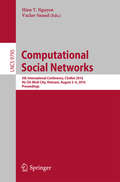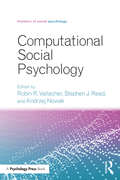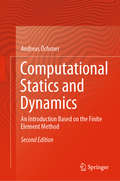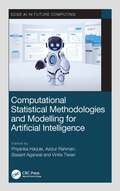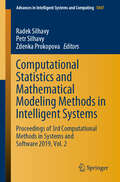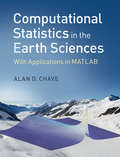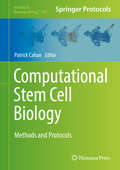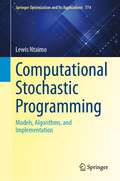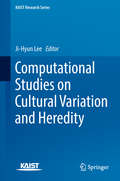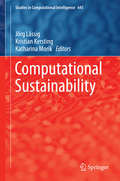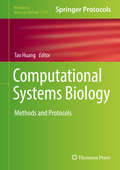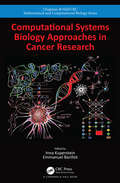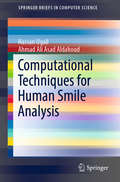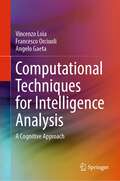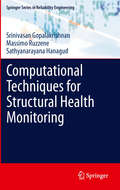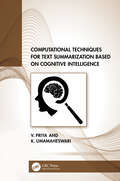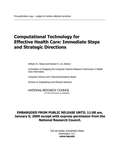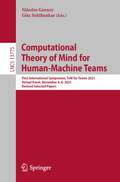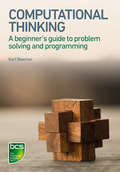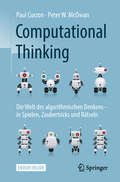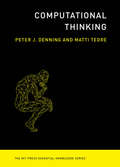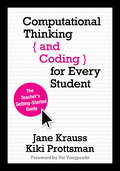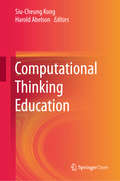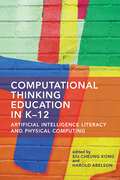- Table View
- List View
Computational Social Networks: 5th International Conference, CSoNet 2016, Ho Chi Minh City, Vietnam, August 2-4, 2016, Proceedings (Lecture Notes in Computer Science #9795)
by Hien T. Nguyen Vaclav SnaselSocial networks provide a powerful abstraction of the structure and dynamics of diverse kinds of people or people-to-technology interaction. Web 2. 0 has enabled a new generation of web-based communities, social networks, and folksonomies to facilitate collaboration among different communities. This unique text/reference compares and contrasts the ethological approach to social behavior in animals with web-based evidence of social interaction, perceptual learning, information granulation, the behavior of humans and affinities between web-based social networks. An international team of leading experts present the latest advances of various topics in intelligent-social-networks and illustrates how organizations can gain competitive advantages by applying the different emergent techniques in real-world scenarios. The work incorporates experience reports, survey articles, and intelligence techniques and theories with specific network technology problems. Topics and Features: Provides an overview social network tools, and explores methods for discovering key players in social networks, designing self-organizing search systems, and clustering blog sites, surveys techniques for exploratory analysis and text mining of social networks, approaches to tracking online community interaction, and examines how the topological features of a system affects the flow of information, reviews the models of network evolution, covering scientific co-citation networks, nature-inspired frameworks, latent social networks in e-Learning systems, and compound communities, examines the relationship between the intent of web pages, their architecture and the communities who take part in their usage and creation, discusses team selection based on members social context, presents social network applications, including music recommendation and face recognition in photographs, explores the use of social networks in web services that focus on the discovery stage in the life cycle of these web services. This useful and comprehensive volume will be indispensible to senior undergraduate and postgraduate students taking courses in Social Intelligence, as well as to researchers, developers, and postgraduates interested in intelligent-social-networks research and related areas. "
Computational Social Psychology (Frontiers of Social Psychology)
by Robin R. Vallacher; Stephen J. Read; Andrzej NowakComputational Social Psychology showcases a new approach to social psychology that enables theorists and researchers to specify social psychological processes in terms of formal rules that can be implemented and tested using the power of high speed computing technology and sophisticated software. This approach allows for previously infeasible investigations of the multi-dimensional nature of human experience as it unfolds in accordance with different temporal patterns on different timescales. In effect, the computational approach represents a rediscovery of the themes and ambitions that launched the field over a century ago. The book brings together social psychologists with varying topical interests who are taking the lead in this redirection of the field. Many present formal models that are implemented in computer simulations to test basic assumptions and investigate the emergence of higher-order properties; others develop models to fit the real-time evolution of people’s inner states, overt behavior, and social interactions. Collectively, the contributions illustrate how the methods and tools of the computational approach can investigate, and transform, the diverse landscape of social psychology.
Computational Statics and Dynamics: An Introduction Based on the Finite Element Method
by Andreas ÖchsnerThis book is the 2nd edition of an introduction to modern computational mechanics based on the finite element method. It includes more details on the theory, more exercises, and more consistent notation; in addition, all pictures have been revised. Featuring more than 100 pages of new material, the new edition will help students succeed in mechanics courses by showing them how to apply the fundamental knowledge they gained in the first years of their engineering education to more advanced topics. In order to deepen readers’ understanding of the equations and theories discussed, each chapter also includes supplementary problems. These problems start with fundamental knowledge questions on the theory presented in the respective chapter, followed by calculation problems. In total, over 80 such calculation problems are provided, along with brief solutions for each. This book is especially designed to meet the needs of Australian students, reviewing the mathematics covered in their first two years at university. The 13-week course comprises three hours of lectures and two hours of tutorials per week.
Computational Statistical Methodologies and Modeling for Artificial Intelligence (ISSN)
by Priyanka Harjule Azizur Rahman Basant Agarwal Vinita TiwariThis book covers computational statistics-based approaches for Artificial Intelligence. The aim of this book is to provide comprehensive coverage of the fundamentals through the applications of the different kinds of mathematical modelling and statistical techniques and describing their applications in different Artificial Intelligence systems. The primary users of this book will include researchers, academicians, postgraduate students, and specialists in the areas of data science, mathematical modelling, and Artificial Intelligence. It will also serve as a valuable resource for many others in the fields of electrical, computer, and optical engineering.The key features of this book are: Presents development of several real-world problem applications and experimental research in the field of computational statistics and mathematical modelling for Artificial Intelligence Examines the evolution of fundamental research into industrialized research and the transformation of applied investigation into real-time applications Examines the applications involving analytical and statistical solutions, and provides foundational and advanced concepts for beginners and industry professionals Provides a dynamic perspective to the concept of computational statistics for analysis of data and applications in intelligent systems with an objective of ensuring sustainability issues for ease of different stakeholders in various fields Integrates recent methodologies and challenges by employing mathematical modeling and statistical techniques for Artificial Intelligence
Computational Statistics and Mathematical Modeling Methods in Intelligent Systems: Proceedings of 3rd Computational Methods in Systems and Software 2019, Vol. 2 (Advances in Intelligent Systems and Computing #1047)
by Radek Silhavy Petr Silhavy Zdenka ProkopovaThis book presents real-world problems and exploratory research in computational statistics, mathematical modeling, artificial intelligence and software engineering in the context of the intelligent systems. This book constitutes the refereed proceedings of the 3rd Computational Methods in Systems and Software 2019 (CoMeSySo 2019), a groundbreaking online conference that provides an international forum for discussing the latest high-quality research results.
Computational Statistics in the Earth Sciences: With Applications in MATLAB
by Chave Alan D.Based on a course taught by the author, this book combines the theoretical underpinnings of statistics with the practical analysis of Earth sciences data using MATLAB. The book is organized to introduce the underlying concepts, and then extends these to the data, covering methods that are most applicable to Earth sciences. Topics include classical parametric estimation and hypothesis testing, and more advanced least squares-based, nonparametric, and resampling estimators. Multivariate data analysis, not often encountered in introductory texts, is presented later in the book, and compositional data is treated at the end. Datasets and bespoke MATLAB scripts used in the book are available online, as well as additional datasets and suggested questions for use by instructors. Aimed at entering graduate students and practicing researchers in the Earth and ocean sciences, this book is ideal for those who want to learn how to analyse data using MATLAB in a statistically-rigorous manner.
Computational Stem Cell Biology: Methods and Protocols (Methods in Molecular Biology #1975)
by Patrick CahanThis volume details methods and protocols to further the study of stem cells within the computational stem cell biology (CSCB) field. Chapters are divided into four sections covering the theory and practice of modeling of stem cell behavior, analyzing single cell genome-scale measurements, reconstructing gene regulatory networks, and metabolomics. Written in the highly successful Methods in Molecular Biology series format, chapters include introductions to their respective topics, lists of the necessary materials and reagents, step-by-step, readily reproducible laboratory protocols, and tips on troubleshooting and avoiding known pitfalls.Authoritative and cutting-edge, Computational Stem Cell Biology: Methods and Protocols will be an invaluable guide to researchers as they explore stem cells from the perspective of computational biology.
Computational Stochastic Programming: Models, Algorithms, and Implementation (Springer Optimization and Its Applications #774)
by Lewis NtaimoThis book provides a foundation in stochastic, linear, and mixed-integer programming algorithms with a focus on practical computer algorithm implementation. The purpose of this book is to provide a foundational and thorough treatment of the subject with a focus on models and algorithms and their computer implementation. The book’s most important features include a focus on both risk-neutral and risk-averse models, a variety of real-life example applications of stochastic programming, decomposition algorithms, detailed illustrative numerical examples of the models and algorithms, and an emphasis on computational experimentation. With a focus on both theory and implementation of the models and algorithms for solving practical optimization problems, this monograph is suitable for readers with fundamental knowledge of linear programming, elementary analysis, probability and statistics, and some computer programming background. Several examples of stochastic programming applications areincluded, providing numerical examples to illustrate the models and algorithms for both stochastic linear and mixed-integer programming, and showing the reader how to implement the models and algorithms using computer software.
Computational Studies on Cultural Variation and Heredity (Kaist Research Ser.)
by Ji-Hyun LeeThis book explores the emerging concept of cultural DNA, considering its application across different fields and examining commonalities in approach. It approaches the subject from four different perspectives, in which the topics include theories, analysis and synthesis of cultural DNA artefacts. After an opening section which reviews theoretical work on cultural DNA research, the second section discusses analysis & synthesis of cultural DNA at the urban scale. Section three covers analysis & synthesis of cultural DNA artefacts, and the final section offers approaches to grammar-based cultural DNA research.The book places emphasis on two specific axes: one is the scale of the object under discussion, which ranges from the small (handheld artefacts) to the very large (cities); and the other is the methodology used from analysis to synthesis. This diverse approach with detailed information about grammar-based methodologies toward cultural DNA makes the book unique.This book will serve as a source of inspiration for designers and researchers trying to find the essence, archetype, and the building blocks of our environment for the incorporation of social and cultural factors into their designs.
Computational Sustainability (Studies in Computational Intelligence #645)
by Kristian Kersting Jörg Lässig Katharina MorikThe book athand gives an overview of the state of the art research in ComputationalSustainability as well as case studies of different application scenarios. Thiscovers topics such as renewable energy supply, energy storage and e-mobility, efficiencyin data centers and networks, sustainable food and water supply, sustainablehealth, industrial production and quality, etc. The book describescomputational methods and possible application scenarios.
Computational Systems Biology: Methods And Protocols (Methods In Molecular Biology #1754)
by Tao HuangThis volume introduces the reader to the latest experimental and bioinformatics methods for DNA sequencing, RNA sequencing, cell-free tumour DNA sequencing, single cell sequencing, single-cell proteomics and metabolomics. Chapters detail advanced analysis methods, such as Genome-Wide Association Studies (GWAS), machine learning, reconstruction and analysis of gene regulatory networks and differential coexpression network analysis, and gave a practical guide for how to choose and use the right algorithm or software to handle specific high throughput data or multi-omics data. Written in the highly successful Methods in Molecular Biology series format, chapters include introductions to their respective topics, lists of the necessary materials and reagents, step-by-step, readily reproducible laboratory protocols, and tips on troubleshooting and avoiding known pitfalls.Authoritative and cutting-edge, Computational Systems Biology: Methods and Protocols aims to ensure successful results in the further study of this vital field.
Computational Systems Biology Approaches in Cancer Research (Chapman & Hall/CRC Computational Biology Series)
by Inna Kuperstein Emmanuel BarillotPraise for Computational Systems BiologyApproaches in Cancer Research: "Complex concepts are written clearly and with informative illustrations and useful links. The book is enjoyable to read yet provides sufficient depth to serve as a valuable resource for both students and faculty." — Trey Ideker, Professor of Medicine, UC Xan Diego, School of Medicine "This volume is attractive because it addresses important and timely topics for research and teaching on computational methods in cancer research. It covers a broad variety of approaches, exposes recent innovations in computational methods, and provides acces to source code and to dedicated interactive web sites." — Yves Moreau, Department of Electrical Engineering, SysBioSys Centre for Computational Systems Biology, University of Leuven With the availability of massive amounts of data in biology, the need for advanced computational tools and techniques is becoming increasingly important and key in understanding biology in disease and healthy states. This book focuses on computational systems biology approaches, with a particular lens on tackling one of the most challenging diseases - cancer. The book provides an important reference and teaching material in the field of computational biology in general and cancer systems biology in particular. The book presents a list of modern approaches in systems biology with application to cancer research and beyond. It is structured in a didactic form such that the idea of each approach can easily be grasped from the short text and self-explanatory figures. The coverage of topics is diverse: from pathway resources, through methods for data analysis and single data analysis to drug response predictors, classifiers and image analysis using machine learning and artificial intelligence approaches. Features Up to date using a wide range of approaches Applicationexample in each chapter Online resources with useful applications’
Computational Techniques for Human Smile Analysis (SpringerBriefs in Computer Science)
by Hassan Ugail Ahmad Ali AldahoudIn this book, the authors discuss the recent developments in computational techniques for automated non-invasive facial emotion detection and analysis with particular focus on the smile. By way of applications, they discuss how genuine and non-genuine smiles can be inferred, how gender is encoded in a smile and how it is possible to use the dynamics of a smile itself as a biometric feature. It is often said that the face is a window to the soul. Bearing a metaphor of this nature in mind, one might find it intriguing to understand, if any, how the physical, behavioural as well as emotional characteristics of a person could be decoded from the face itself. With the increasing deductive power of machine learning techniques, it is becoming plausible to address such questions through the development of appropriate computational frameworks. Though there are as many as over twenty five categories of emotions one could express, regardless of the ethnicity, gender or social class, across humanity, there exist six common emotions – namely happiness, sadness, surprise, fear, anger and disgust - all of which can be inferred from facial expressions. Of these facial expressions, the smile is the most prominent in social interactions. The smile bears important ramifications with beliefs such as it makes one more attractive, less stressful in upsetting situations and employers tending to promote people who smile often. Even pockets of scientific research appear to be forthcoming to validate such beliefs and claims, e.g. the smile intensity observed in photographs positively correlates with longevity, the ability to win a fight and whether a couple would stay married. Thus, it appears that many important personality traits are encoded in the smile itself. Therefore, the deployment of computer based algorithms for studying the human smiles in greater detail is a plausible avenue for which the authors have dedicated the discussions in this book.
Computational Techniques for Intelligence Analysis: A Cognitive Approach
by Vincenzo Loia Francesco Orciuoli Angelo GaetaThis book focuses on the definition and implementation of data-driven computational tools supporting decision-making along heterogeneous intelligence scenarios. Intelligence analysis includes methodologies, activities, and tools aimed at obtaining complex information from a set of isolated data gathered from different sensors. The tools aim at increasing the level of situation awareness of decision-makers through the construction of abstract structures supporting human operators in reasoning and making decisions. This book appeals to students, professionals, and academic researchers in computational intelligence and approximate reasoning applications. It is a comprehensive textbook on the subject, supported with case studies and practical examples in Python. The readers will learn how to define decision support systems for the intelligence analysis through the application of situation awareness and granular computing for information processing.
Computational Techniques for Structural Health Monitoring (Springer Series in Reliability Engineering)
by Srinivasan Gopalakrishnan Sathyanaraya Hanagud Massimo RuzzeneThe increased level of activity on structural health monitoring (SHM) in various universities and research labs has resulted in the development of new methodologies for both identifying the existing damage in structures and predicting the onset of damage that may occur during service. Designers often have to consult a variety of textbooks, journal papers and reports, because many of these methodologies require advanced knowledge of mechanics, dynamics, wave propagation, and material science. Computational Techniques for Structural Health Monitoring gives a one-volume, in-depth introduction to the different computational methodologies available for rapid detection of flaws in structures. Techniques, algorithms and results are presented in a way that allows their direct application. A number of case studies are included to highlight further the practical aspects of the selected topics. Computational Techniques for Structural Health Monitoring also provides the reader with numerical simulation tools that are essential to the development of novel algorithms for the interpretation of experimental measurements, and for the identification of damage and its characterization. Upon reading Computational Techniques for Structural Health Monitoring, graduate students will be able to begin research-level work in the area of structural health monitoring. The level of detail in the description of formulation and implementation also allows engineers to apply the concepts directly in their research.
Computational Techniques for Text Summarization based on Cognitive Intelligence
by V. Priya K. UmamaheswariThe book is concerned with contemporary methodologies used for automatic text summarization. It proposes interesting approaches to solve well-known problems on text summarization using computational intelligence (CI) techniques including cognitive approaches. A better understanding of the cognitive basis of the summarization task is still an open research issue; an extent of its use in text summarization is highlighted for further exploration. With the ever-growing text, people in research have little time to spare for extensive reading, where summarized information helps for a better understanding of the context at a shorter time. This book helps students and researchers to automatically summarize the text documents in an efficient and effective way. The computational approaches and the research techniques presented guides to achieve text summarization at ease. The summarized text generated supports readers to learn the context or the domain at a quicker pace. The book is presented with reasonable amount of illustrations and examples convenient for the readers to understand and implement for their use. It is not to make readers understand what text summarization is, but for people to perform text summarization using various approaches. This also describes measures that can help to evaluate, determine, and explore the best possibilities for text summarization to analyse and use for any specific purpose. The illustration is based on social media and healthcare domain, which shows the possibilities to work with any domain for summarization. The new approach for text summarization based on cognitive intelligence is presented for further exploration in the field.
Computational Technology For Effective Health Care: Immediate Steps And Strategic Directions
by National Research Council of the National AcademiesDespite a strong commitment to delivering quality health care, persistent problems involving medical errors and ineffective treatment continue to plague the industry. Many of these problems are the consequence of poor information and technology (IT) capabilities, and most importantly, the lack cognitive IT support. Clinicians spend a great deal of time sifting through large amounts of raw data, when, ideally, IT systems would place raw data into context with current medical knowledge to provide clinicians with computer models that depict the health status of the patient. Computational Technology for Effective Health Care advocates re-balancing the portfolio of investments in health care IT to place a greater emphasis on providing cognitive support for health care providers, patients, and family caregivers; observing proven principles for success in designing and implementing IT; and accelerating research related to health care in the computer and social sciences and in health/biomedical informatics. Health care professionals, patient safety advocates, as well as IT specialists and engineers, will find this book a useful tool in preparation for crossing the health care IT chasm.
Computational Theory of Mind for Human-Machine Teams: First International Symposium, ToM for Teams 2021, Virtual Event, November 4–6, 2021, Revised Selected Papers (Lecture Notes in Computer Science #13775)
by Nikolos Gurney Gita SukthankarThis book constitutes the proceedings of the First International Symposium, ToM for Teams 2021, held in Washington, DC, USA, during November 4–6, 2021, Each chapter in this section tackles a different aspect of AI representing the thoughts and beliefs of human agents. The work presented herein represents our collective efforts to better understand ToM, develop AI with ToM capabilities (ASI), and study how to integrate such systems into human teams.
Computational Thinking: A Beginner's Guide to Problem-Solving and Programming
by Karl BeecherComputational thinking is a timeless, transferable skill that enables you to think more clearly and logically, as well as a way to solve specific problems. <p><p> Beginning with the core ideas of computational thinking, with this book you'll build up an understanding of the practical problem-solving approach and explore how computational thinking aids good practice in programming, complete with a full guided example.
Computational Thinking: Des Welt des algorithmischen Denkens – in Spielen, Zaubertricks und Rätseln
by Paul Curzon Peter W. McOwan Bernhard GerlIn diesem Buch lernen Sie die Grundzüge und Vorteile des Computational Thinking kennen, also des analytischen, von Algorithmen geprägten Denkens. Die Autoren behandeln dabei unterhaltsam und anwendungsbezogen die Grundelemente dieser Denkweise - darunter Denken in Algorithmen, Zerlegung, Abstraktion und Mustererkennung. Diese Prinzipien werden anschaulich an Hand von Zaubertricks, Spielen und Rätseln, aber auch an echten, anspruchsvollen Problemen erklärt. Sie erkunden dabei auch die Verbindungen zwischen Computational Thinking und wissenschaftlichem, aber auch kreativem Denken - und wie daraus Innovationen entstehen können.Computational Thinking hat die Art und Weise, wie wir alle leben, arbeiten und spielen, verändert. Es hat Auswirkungen darauf, wie Wissenschaft betrieben wird, Kriege gewonnen, ganz neue Industrien geschaffen und Leben gerettet werden. Es ist das Herzstück der Programmierung und ein leistungsfähiger Ansatz zur Problemlösung, mit oder ohne Computer. In einigen Ländern werden bereits Kindern in der Grundschule diese Fertigkeiten beigebracht.Ob Sie also einfach wissen wollen, um was es beim Computational Thinking geht oder ob Sie neue Möglichkeiten finden wollen, auch im Alltag effektiver zu werden, ob Sie (Informatik-)Lehrer oder Schüler sind oder einfach Spaß an Spielen und Rätseln haben – in diesem Buch finden Sie die nötigen Grundlagen.
Computational Thinking (The MIT Press Essential Knowledge Series)
by Peter J. Denning Matti TedreAn introduction to computational thinking that traces a genealogy beginning centuries before the digital computer. A few decades into the digital era, scientists discovered that thinking in terms of computation made possible an entirely new way of organizing scientific investigation; eventually, every field had a computational branch: computational physics, computational biology, computational sociology. More recently, “computational thinking” has become part of the K–12 curriculum. But what is computational thinking? This volume in the MIT Press Essential Knowledge series offers an accessible overview, tracing a genealogy that begins centuries before digital computers and portraying computational thinking as pioneers of computing have described it. The authors explain that computational thinking (CT) is not a set of concepts for programming; it is a way of thinking that is honed through practice: the mental skills for designing computations to do jobs for us, and for explaining and interpreting the world as a complex of information processes. Mathematically trained experts (known as “computers”) who performed complex calculations as teams engaged in CT long before electronic computers. The authors identify six dimensions of today's highly developed CT—methods, machines, computing education, software engineering, computational science, and design—and cover each in a chapter. Along the way, they debunk inflated claims for CT and computation while making clear the power of CT in all its complexity and multiplicity.
Computational Thinking and Coding for Every Student: The Teacher’s Getting-Started Guide
by Jane Krauss Kiki ProttsmanEmpower tomorrow’s tech innovators Our students are avid users and consumers of technology. Isn’t it time that they see themselves as the next technological innovators, too? Computational Thinking and Coding for Every Student is the beginner’s guide for K-12 educators who want to learn to integrate the basics of computer science into their curriculum. Readers will find Strategies and activities for teaching computational thinking and coding inside and outside of school, at any grade level, across disciplines Instruction-ready lessons for every grade A discussion guide and companion website with videos, activities, and other resources
Computational Thinking and Coding for Every Student: The Teacher’s Getting-Started Guide
by Jane Krauss Kiki ProttsmanEmpower tomorrow’s tech innovators Our students are avid users and consumers of technology. Isn’t it time that they see themselves as the next technological innovators, too? Computational Thinking and Coding for Every Student is the beginner’s guide for K-12 educators who want to learn to integrate the basics of computer science into their curriculum. Readers will find Strategies and activities for teaching computational thinking and coding inside and outside of school, at any grade level, across disciplines Instruction-ready lessons for every grade A discussion guide and companion website with videos, activities, and other resources
Computational Thinking Education
by Siu-Cheung Kong Harold AbelsonThis This book is open access under a CC BY 4.0 license.This book offers a comprehensive guide, covering every important aspect of computational thinking education. It provides an in-depth discussion of computational thinking, including the notion of perceiving computational thinking practices as ways of mapping models from the abstraction of data and process structures to natural phenomena. Further, it explores how computational thinking education is implemented in different regions, and how computational thinking is being integrated into subject learning in K-12 education. In closing, it discusses computational thinking from the perspective of STEM education, the use of video games to teach computational thinking, and how computational thinking is helping to transform the quality of the workforce in the textile and apparel industry.
Computational Thinking Education in K-12: Artificial Intelligence Literacy and Physical Computing
by Siu-Cheung Kong and Harold AbelsonA guide to computational thinking education, with a focus on artificial intelligence literacy and the integration of computing and physical objects. Computing has become an essential part of today&’s primary and secondary school curricula. In recent years, K–12 computer education has shifted from computer science itself to the broader perspective of computational thinking (CT), which is less about technology than a way of thinking and solving problems—&“a fundamental skill for everyone, not just computer scientists,&” in the words of Jeanette Wing, author of a foundational article on CT. This volume introduces a variety of approaches to CT in K–12 education, offering a wide range of international perspectives that focus on artificial intelligence (AI) literacy and the integration of computing and physical objects. The book first offers an overview of CT and its importance in K–12 education, covering such topics as the rationale for teaching CT; programming as a general problem-solving skill; and the &“phenomenon-based learning&” approach. It then addresses the educational implications of the explosion in AI research, discussing, among other things, the importance of teaching children to be conscientious designers and consumers of AI. Finally, the book examines the increasing influence of physical devices in CT education, considering the learning opportunities offered by robotics. ContributorsHarold Abelson, Cynthia Breazeal, Karen Brennan, Michael E. Caspersen, Christian Dindler, Daniella DiPaola, Nardie Fanchamps, Christina Gardner-McCune, Mark Guzdial, Kai Hakkarainen, Fredrik Heintz, Paul Hennissen, H. Ulrich Hoppe, Ole Sejer Iversen, Siu-Cheung Kong, Wai-Ying Kwok, Sven Manske, Jesús Moreno-León, Blakeley H. Payne, Sini Riikonen, Gregorio Robles, Marcos Román-González, Pirita Seitamaa-Hakkarainen, Ju-Ling Shih, Pasi Silander, Lou Slangen, Rachel Charlotte Smith, Marcus Specht, Florence R. Sullivan, David S. Touretzky
